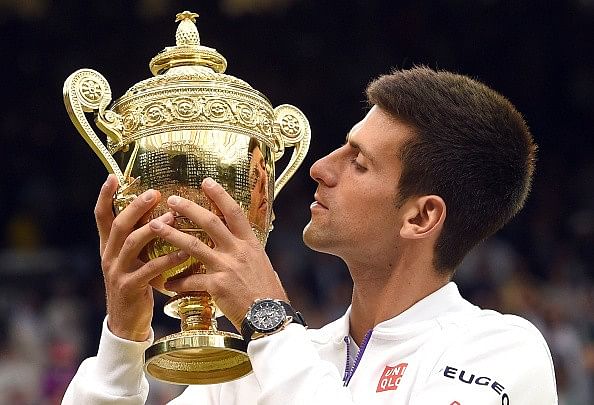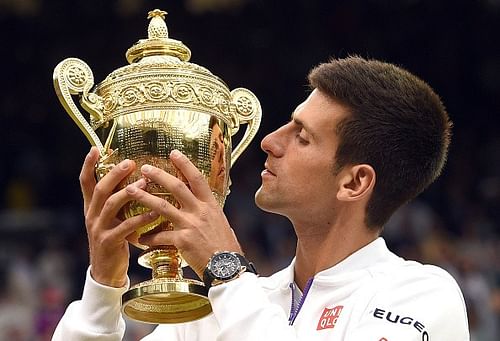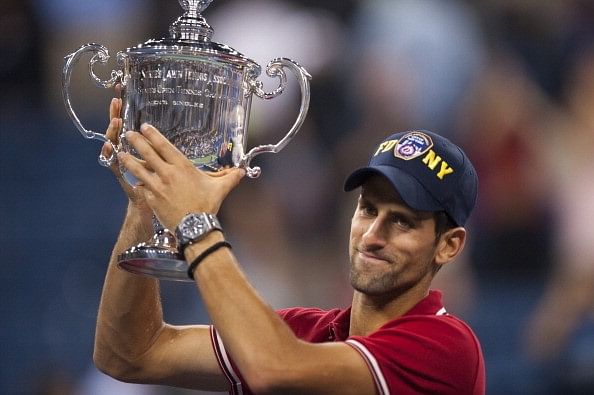
Novak Djokovic: Man or machine?

What makes Novak Djokovic special? Is it his haul of nine Grand Slam titles? Or his ability to fight for every single point, chase down every single ball, no matter how futile it may seem? The more we see him play, the more we realize he is no ordinary human being. After all, it has to take something special to reach 17 Grand Slam finals while playing among peers such as Roger Federer, Andy Murray and Rafael Nadal.
The consistency of Djokovic’s game is astounding. His ability to hit the same ball to 50 different spots on the court is something that cannot be taught. But ultimately, it is his champion’s mentality that separates him from the rest of the pack.
The early years
Djokovic was born and raised in Serbia under the stern guidance of coach Jelena Gencic, who gave shape to the first few parts of what would become the ultimate competitive machine. Moving to Germany to improve his game, the lanky kid’s potential was easy to spot. A champion at under-14 and under-16 levels, it wasn’t going to be long before Djokovic made his professional breakthrough.
He earned his first ATP points by winning the Futures tournament hosted by tennis club Red Star.
Djokovic played his first Davis Cup match in a tie against Latvia and earned his team a point. He won his first ATP Challenger tournament in Budapest, where he started as a qualifier, and followed that with another challenger event in Germany, finishing the 2004 season with a ranking of 184 in the world. This was just the beginning of things to come.
Emergence of a powerhouse
2005 was Djokovic’s biggest year up to that point of his career. He qualified for his first Grand Slam in Australia and made the third round at Wimbledon, followed by the third round at the US Open, ending the year ranked 78th in the world.
His first real success, however, came in the 2007 season where he won a title at Adelaide followed by making the quarters at the Australian Open and finals at the US Open. Success at Montreal catapulted him into the top 3, a spot he maintained for 91 weeks.
But for all his talent, he was yet to win a Grand Slam.
The first Grand Slam
This would soon change as he demolished Roger Federer in the semis of the 2008 Australian Open, and went on to clinch the title by beating Jo-Wilfried Tsonga in the finals. This was when people first realised that Djokovic was here to stay.
Success in Melbourne opened the floodgates. Win after win propelled him to the World No. 2 spot, as he inched ever closer to his dream of being World No. 1. But there was a long way to go. With only one Grand Slam under his belt, he was, even then, treated as a flashy kid on the block trying to ply his trade with the big boys.
The Djoker was consistently making quarters and semifinals, but his lack of fitness was a concern to many. He would often pull out of matches or suffer from heatstroke and other ailments during matches. He was nowhere near his optimal form, and he knew it.
During the off-season, he began to go through a rigorous training program and switched to a gluten-free diet which would eventually pay dividends. It took him that much closer to being the fittest person on the planet.
Entry into the record books
2011 was the making of the machine. A 43-game winning streak at the start of the season cemented his place in history. He finally managed to achieve his coveted dream of lifting the Wimbledon trophy and he followed it up with victory at the US Open.
In a statement he said: “I was dreaming of becoming number one. Wimbledon was in those dreams. Then, in a span of just two days, my dreams came true.”

2012 began with another Australian Open title. He had become one of the fiercest and fittest competitors on tour as could be inferred from his 5 hour, 53 minute marathon final against Nadal.
Djokovic received the Sportsman of the Year Laureus Award that year – it is the most prestigious sports award voted by an Academy which consists of the biggest sporting legends of all time.
The Republic of Serbia awarded him the top state honour in the country, “Karadjordjeva Star Medal”, for special merits and success in representing Serbia. He was also named one of TIME Magazine’s Top 100 most influential people in the world,
Djokovic was awarded two exceptional honours for his 2012 season: the Arthur Ashe Humanitarian of the Year, which acknowledges outstanding humanitarian contribution, and the ATP World Tour No.1 award .
He had finally, well and truly, established himself as the World No. 1.
Maintaining the stranglehold
Another record had Djokovic’s name on it when he won the Australian Open for a third successive time in 2013. Records kept tumbling, and there was no stopping the Serbian juggernaut.
In 2014 he had another Wimbledon to add to his already growing list of singles titles. With seven Grand Slam titles, he had surpassed Boris Becker and moved closer to overhauling John McEnroe. The only one title missing was the French Open, which he was denied yet again by Nadal.
A teary Djokovic swore to be back. He ended the year at No. 1 yet again.
2015 began in similar fashion to the other years, with the Serb capturing his fifth Australian Open defeating Andy Murray in the finals yet again. He followed this up with another Roland Garros final, but was again beaten to the summit this time by Stan Wawrinka. Devastated, he opted for some time off, returning to capture his third Wimbledon title and ninth Grand Slam in total.
Still only 28 and in the prime of his career, Djokovic is a true role model for budding youngsters looking to take up the game. He is the perfect athlete and gentleman to boot. Will we ever see another like him?
Thank You, Novak, for giving us all the pleasure to watch you do what you do best.